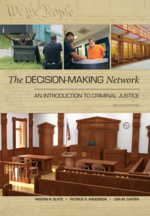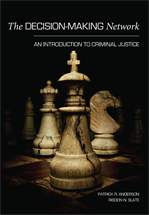This title has been replaced by a newer edition:
The Decision-Making Network: An Introduction to Criminal Justice, Second Edition
2018, 734 pp, paper, ISBN 978-1-5310-0298-5
$90.00
Teacher's Manual available
The Decision-Making Network
An Introduction to Criminal Justice
by Patrick R. Anderson, Risdon N. Slate
2011
Tags: Introduction to Criminal Justice
Teacher's Manual available
552 pp $55.00
ISBN 978-1-59460-836-0
eISBN 978-1-61163-251-4
The Decision-Making Network presents criminal justice to undergraduate students as a network of interrelated decisions made by diverse actors in multiple agencies. Legislative decisions about what should be the content of the criminal law, police officers' decisions regarding investigation and arrest, prosecutors' decisions regarding whether to prosecute and what charges to bring, judges' decisions, appellate court decisions, juries' decisions, correctional decisions … all comprise the complex network of criminal justice.
This text examines criminal justice decisions in historical context with attention to the Constitutional values and principles which undergird American criminal justice. Students learn how crises often drive the making of law, the development of policies, and the practice of criminal justice. It examines the tensions between civil liberties and public safety, and it introduces the challenges of terrorism, immigration, drug enforcement, and other emerging issues which confront the criminal justice decision maker.
"There are many introduction to criminal justice textbooks; only a few can be considered "classics." This is one of those. When the late Don Newman conceived this text and when Pat Anderson joined him as a co-author, the approach was unique in getting students to consider not "what" criminal justice is but, rather, how decision-making at various points dynamically affects what we think of as the disparate segments of the criminal justice system. With the addition of Ris Slate in the contemporary version, the decision-making approach continues and is updated to today's contentious times in which legislative decisions made for ideological reasons result in public expectations at odds with pragmatic criminal justice decisions in the field. One of the most difficult tasks in teaching criminal justice is getting students to understand how ideological views of crime affect the practical nature of decision-making on the streets, in the offices, and around the courtrooms. By introducing these ideas at the level of an introductory course, this text makes a professor's job substantially easier." — Frank P. Williams III, University of Houston-Downtown
"The text presents the criminal justice system in a manner different than other texts—as a complicated network influenced by a variety of actors, many of whom are behind-the-scenes and perhaps motivated by interests other than public safety. This framework for the text is particularly useful, as it helps students to appreciate the complexity of case processing, and more importantly, to understand why things are done as they are done." — Sharon Chamard, University of Alaska Anchorage
"The Decision-Making Network is a refreshing alternative to the traditional introduction to criminal justice textbook. As an assistant professor teaching a minimum of four introductory level criminal justice courses per year I value the approach taken by Anderson and Slate in this new text. This book includes both the historical, procedural and constitutional issues necessary for a criminal justice textbook as well as a focus on the values and context surrounding the application of justice in our crime control system. The critical analysis of how social crisis drives public policy concerning crime control is especially inspiring and is sure to invigorate meaningful classroom discussion and enhance critical thinking skills in our students. This book provides not only an overview of the criminal justice system, as is expected of any introduction to criminal justice textbook, but also invites students to ask "Why does the system work the way it does?" and "Is this the best possible way of providing justice?" These are valuable skills for any student entering "the decision-making network" after graduation." — Suzanne M. Godboldt, Ph.D., Mercyhurst College
The Teacher's Manual is available electronically on a CD or via email. Please contact Beth Hall at bhall@cap-press.com to request a copy. PowerPoint slides are available upon adoption. Sample slides from the full, 658-slide presentation are available to view here. Email bhall@cap-press.com for more information.



